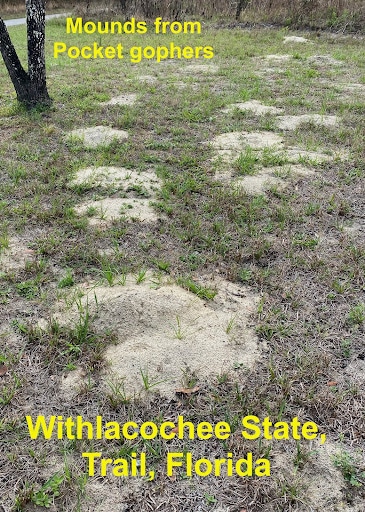By Ann Abeles, a Withlacoochee State Trail Volunteer
The sandy sides of the Withlacoochee State Trail seem to attract a variety of critters that like to leave mounds of fresh soil or sand along the Trail. Sometimes these are quite small, some are large, some mounds seem to follow a straight line while others are random. Who is digging here and there along the Trail? The answer turns out to be that there are several different animals and insects that are responsible. The biggest mounds have a large opening at one side and are the entrances to the Gopher Tortoise, Gopherus polyphemus, burrows. These land reptiles dig long (up to 15 feet), deep (over 6 feet) burrows in the sandy soils common in the longleaf pine forests along the Trail. Another post will describe them in more detail.
Somewhat smaller mounds with no openings are due to the Pocket gopher, Geomys pinetis. The females tend to burrow in a straight line, pushing up piles of soil as they create their extensive burrows while collecting bits of roots, seeds and other vegetation to store in chambers for later consumption. The males tend to burrow in a random pattern, looking for females to mate with or her storage burrows for an easy meal. You can learn more if you read Heather’s Facebook post from 2/2/2020.
Still smaller mounds are made by several different kinds of insects such as beetles, mining bees, wasps, crickets and ants. Especially interesting is the dung or scarab beetle, also called the Florida deep digger scarab beetle, Peltotrupes profundus, which can dig tunnels up to 10 feet deep. At the bottom, the female makes a small chamber at 90 degrees to the shaft and deposits one egg. She lines the chamber with decaying plant material for the young larva to feed upon. Their small piles of sand do not have holes on the top, helping one to identify these as due to this beetle. You can learn more about these beetles from posts on flapest.com and blogs.ifas.ufl.edu.
- Advertisement -
RELATED ARTICLES

